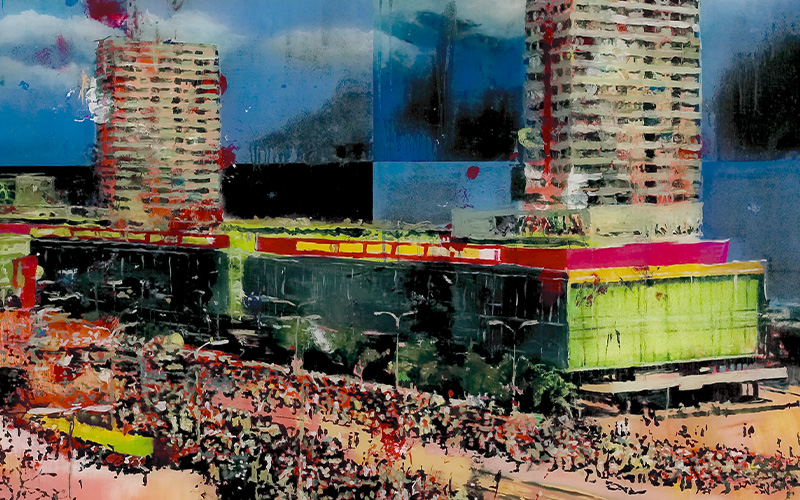In the recesses of memory

If a city like this ever existed, it would make for a great bedtime story. Yet it turns out we are actually already within a dream, cruising the beltway of a sleeping brain, sinking into a corner of memory, as explained in Alberto Manguel’s The Dictionary of Imaginary Places under the entry ‘Mnemopolis’, the name of an imaginary city in Maurice Roche’s novel Compact, which gave the name to the exhibition the artist held at CAM in 2004, curated by me, and which included this work.
Gil H. Cortesão‘s painting is often concerned with urban spaces. Mnemopolis is like an immense fairground or amusement park where crowds gather as an undifferentiated collective magma in open space, our aerial viewpoint giving us a feeling of omnipotent distance. Removed from the collective mass and sheltered from its turmoil, we are able to watch the city’s movements from the mobile and imaginary watchtower in which we are situated.
The near side of the glass, the unpainted surface facing us (with the artist painting on the other side), creates a kind of silence and barrier to the density of that distance. Gil H. Cortesão invoked the concept of the aquarium to explain this separation and demiurgic manner of observation.
Patches, runs and brushstrokes of paint burst and overflow from within the rigid façades of the buildings, undoing any ostensible notion of solidity and seeming to ultimately express the collapse of the modernist utopia through architectural sabotage.
His works always feature other images (photographs), which provide an initial structure that is altered, broken down, dislocated in the painting. In this diptych, the composition of the sky as a poorly arranged geometric puzzle underlines the artificiality of painting in the treatment of any landscape.

It is interesting to note that the painting could be thought of as ‘an organism that grows pale, grows ill, begins to shake, to become enraged, etc.’, a manipulable being whose reality we can only witness as a sterile, silent screen. This circumspection in relation to the city’s voice and noise is most likely a way to avoid its inhumanity.
Indeed, we are unsure whether we want to save this world. When we look at it, it is no longer ours. Perhaps we should allow its finite cycle of existence to draw to a close.
Gil Heitor Cortesão’s work was the subject of several publications signed by me, among which are a book published by ADIAC in 2010 and a long chapter in my doctoral theses, concluded in 2017.
Leonor Nazaré
Curator of the CAM
Curators’ Choices
The curators of the CAM reflect on a selection of works, which include creations by national and international artists.
More choices